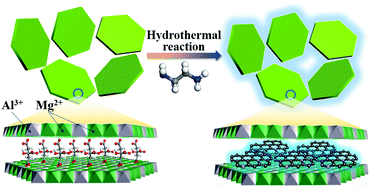In situ synthesis of nitrogen-doped carbon dots in the interlayer region of a layered double hydroxide with tunable quantum yield†
Abstract
Carbon dots (CDs) have drawn considerable research interest due to their fascinating physicochemical properties and optical performance. Herein, we report the preparation of nitrogen-doped carbon dots (N-CDs) via an in situ hydrothermal reaction of citric acid (CA) and ethylenediamine (EDA) in the confined two-dimensional gallery of a layered double hydroxide (LDH). The resulting N-CDs/LDH material shows a long-range ordered structure, with blue-emissive, sheet-like ultrathin N-CDs (∼0.62 nm) accommodated in the LDH gallery. In particular, the photoluminescence quantum yield (PLQY) can be tuned by adjusting the charge density of the LDH host layer, and the maximum value accomplishes 61.63%. This variable performance is attributed to different N-doping contents, which is confirmed by X-ray photoelectron spectroscopy (XPS), elemental analysis and molecular dynamics (MD) simulations. Moreover, the N-CDs/LDH composite exhibits temperature-responsive emission under sub-zero conditions (from −150 °C to 0 °C). Its potential application is demonstrated by incorporating N-CDs/LDH within a polyvinyl alcohol (PVA) polymer matrix, which is then used as a modulator to transfer ultraviolet light to blue emission. This work provides a facile method for the preparation of highly luminescent N-CD-based solid-state materials through an in situ interlayer reaction, which can serve as promising candidates in optical and display devices.



 Please wait while we load your content...
Please wait while we load your content...